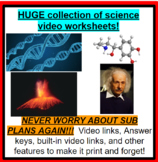The Story of Electricity Documentary worksheet bundle - GREAT SUB PLANS!
Huge House of Science
255 Followers
Grade Levels
5th - 12th
Subjects
Resource Type
Standards
NGSSMS-PS3-4
NGSSHS-PS3-4
NGSSHS-PS3-2
NGSSMS-PS3-2
NGSSHS-PS3-1
Formats Included
- Zip
Pages
6 pages
Huge House of Science
255 Followers
Products in this Bundle (3)
Also included in
- This massive collection of video worksheets covers a number of NGSS standards. Each worksheet has a direct link to the video file built in to the worksheet, each worksheet has either fill in the blank or multiple choice question and EVERY worksheet has an answer key to go with it. Fool proof sub pPrice $37.10Original Price $53.00Save $15.90
- Price $36.80Original Price $46.00Save $9.20
Description
This worksheet bundle includes a direct link to each video, three worksheets with at least 10 multiple choice questions each and an answer key for each. A PERFECT "print and forget" lesson for students studying electricity (and a great sub plan for a three day absence as well).
Total Pages
6 pages
Answer Key
Included
Teaching Duration
3 hours
Report this resource to TPT
Reported resources will be reviewed by our team. Report this resource to let us know if this resource violates TPT’s content guidelines.
Standards
to see state-specific standards (only available in the US).
NGSSMS-PS3-4
Plan an investigation to determine the relationships among the energy transferred, the type of matter, the mass, and the change in the average kinetic energy of the particles as measured by the temperature of the sample. Examples of experiments could include comparing final water temperatures after different masses of ice melted in the same volume of water with the same initial temperature, the temperature change of samples of different materials with the same mass as they cool or heat in the environment, or the same material with different masses when a specific amount of energy is added. Assessment does not include calculating the total amount of thermal energy transferred.
NGSSHS-PS3-4
Plan and conduct an investigation to provide evidence that the transfer of thermal energy when two components of different temperature are combined within a closed system results in a more uniform energy distribution among the components in the system (second law of thermodynamics). Emphasis is on analyzing data from student investigations and using mathematical thinking to describe the energy changes both quantitatively and conceptually. Examples of investigations could include mixing liquids at different initial temperatures or adding objects at different temperatures to water. Assessment is limited to investigations based on materials and tools provided to students.
NGSSHS-PS3-2
Develop and use models to illustrate that energy at the macroscopic scale can be accounted for as a combination of energy associated with the motion of particles (objects) and energy associated with the relative position of particles (objects). Examples of phenomena at the macroscopic scale could include the conversion of kinetic energy to thermal energy, the energy stored due to position of an object above the earth, and the energy stored between two electrically-charged plates. Examples of models could include diagrams, drawings, descriptions, and computer simulations.
NGSSMS-PS3-2
Develop a model to describe that when the arrangement of objects interacting at a distance changes, different amounts of potential energy are stored in the system. Emphasis is on relative amounts of potential energy, not on calculations of potential energy. Examples of objects within systems interacting at varying distances could include: the Earth and either a roller coaster cart at varying positions on a hill or objects at varying heights on shelves, changing the direction/orientation of a magnet, and a balloon with static electrical charge being brought closer to a classmate’s hair. Examples of models could include representations, diagrams, pictures, and written descriptions of systems. Assessment is limited to two objects and electric, magnetic, and gravitational interactions.
NGSSHS-PS3-1
Create a computational model to calculate the change in the energy of one component in a system when the change in energy of the other component(s) and energy flows in and out of the system are known. Emphasis is on explaining the meaning of mathematical expressions used in the model. Assessment is limited to basic algebraic expressions or computations; to systems of two or three components; and to thermal energy, kinetic energy, and/or the energies in gravitational, magnetic, or electric fields.




